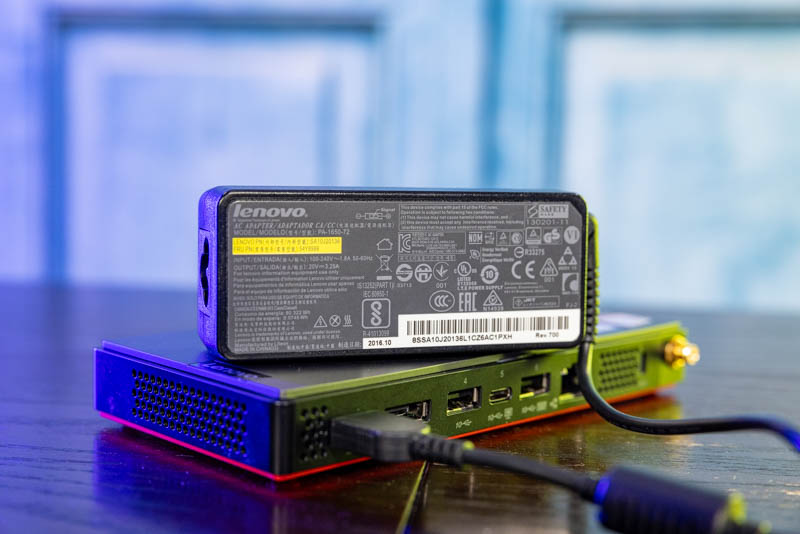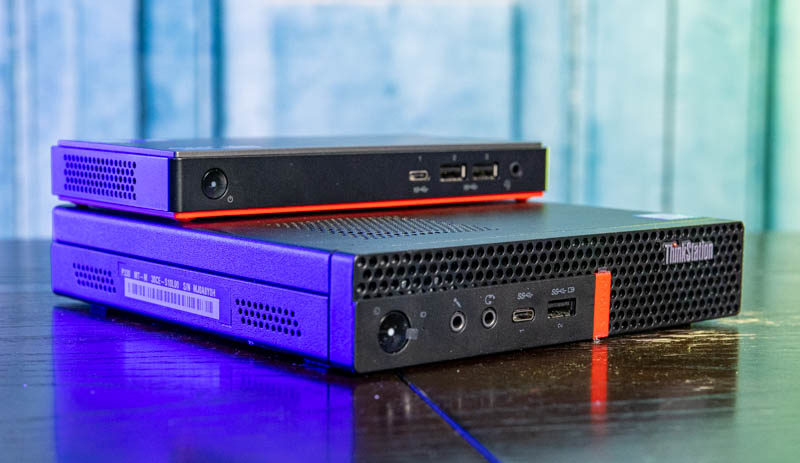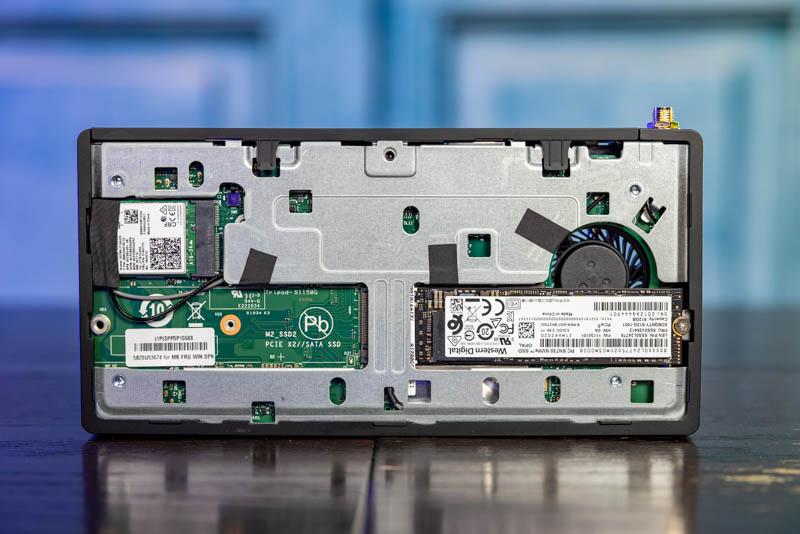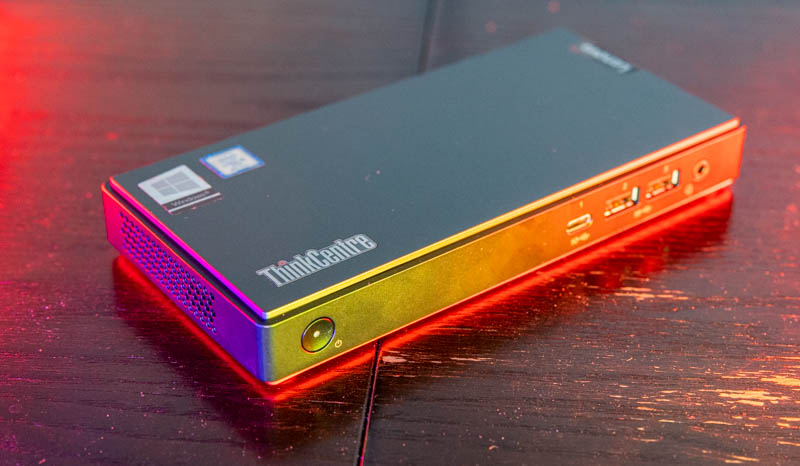Power Consumption
Idle power consumption on 120V power we saw around 9W idle. We generally assume these nodes will use 9-12W idle so this was directly in the range we would expect. Again, we do see power consumption creep slightly higher over time if dust accumulates in the fan/ heatsink and we had a new unit here. Still directionally this is where we would expect.

The power supply for this unit is a 65W Lenovo power adapter from the company’s notebook line. As you would expect, you can use the adapters from the company’s notebooks and also the Intel-based Lenovo Tiny nodes with this machine. We could push the system to around 52W so there is room to spare.
At idle, the system is not silent, but it is very quiet if working from 1M away. It stays fairly quiet under light loads and takes a fairly significant load to get the fans to spin up. One advantage of a lower power system is the lower cooling requirement and thus noise.
Key Lesson Learned for TMM
In this series, we wanted to also focus on some key lessons learned. Since we have already tested well over a dozen different models, we are taking away key pieces of advice from each that we wanted to share.
The lesson learned for Project TinyMiniMicro is fairly straightforward in this case. While Lenovo has succeeded in making a solid and compact desktop, there are reasonable trade-offs that were made to achieve that goal. Performance is lower due to thermal constraints. Memory capacity is generally lower and is not upgradable. We had 8GB of memory but there are 4GB and 16GB models available. In Project TinyMiniMicro nodes, it takes 30-60 seconds to complete an upgrade from 4GB to 64GB (and under $300.)

For single-node servers, our challenge is that this costs more, and is less expandable than a Core i5-8500T on the used market. The Core i5-8500T also supports vPro in higher-end models and those sell for around $300. Even the Dell OptiPlex 3070 Micro we purchased from Dell for just over $330 which is a lower cost and higher-performing new unit.
When we scale out to a cluster, the challenge intensifies. A 2-3 node cluster of these units is $800-1200. That price is in the range of the newer Ryzen 7 Pro 4750GE and Core i5-10500T models that offer significantly more performance, expandability, and newer features such as WiFi 6 at around $800 new. Using nested virtualization, one can get higher than 1GbE speed links found on the M90n between nested virtualization “nodes”. Space is less because one needs a single power adapter. That also means fewer power sockets and network ports. A larger node virtual cluster can be accessed via WiFi for a switch-less solution even since the communication is not going over the 1GbE port.

If running bare metal, then having a single OS on a single machine with more resources will require less overhead than having an OS installed on each node. This is nothing new and is why data centers seek larger servers with more cores and more RAM, we are just applying it to the other side of the compute spectrum.
If you are simply looking for a single server, and the 1L system is too large for you, and you need more performance and less networking than the fanless Lenovo ThinkCentre M90n-IoT offers, then the M90n Nano may make sense. Otherwise, there are simply better options out there.
Final Words
To this day, the Lenovo ThinkCentre M90n Nano brings mixed feelings to mind. The chassis is so small that one can immediately imagine the possibilities for a cluster. At the same time, the multitude of options on the market makes this extraordinarily difficult to recommend for a Project TinyMiniMicro cluster. The small size lends itself well to portability, but ultimately it will be better to consolidate and use nested virtualization on a larger node.

Still, there is something intriguing about such a small form factor. Perhaps it has some of the “cool” factors that the larger models lack. As a compact PC, Lenovo succeeded. As a Project TinyMiniMicro node, it does not make sense for us to expand this to TinyMiniMicroNano.




When reviewing a small-form-factor system that is throttling due to inadequate cooling, it would be nice to include a stress test that directly measured FLOPs, clock speed and temperature over time, for example, while running something like high-performance Linpack. Any similar cooling-system stress test wound be welcome.
It’s Wonderful!
I would like to mount the TinyMiniMicro onto camera tripods, analytical/optical benches (lab), to being part of a package attached to physically larger projects e.g. in the observatory, riding the telescope, to having hardwire ether and more compartmentalized for secure lab/facility, performing dedicated function sets e.g. LabVIEW. I also like the USB 3.1 Gen2 port with the less diminutive A like style connector, rather than being limited to a manufacturer selfish and current trend (creates hardware personality matching issues), less robust/inclusive USB 3.1 C.
I’m really puzzled by the design process that would produce something like this.
For laptops you can understand(if not always agree with) thermal compromises because every gram is a gram that the customer will be carrying around a lot; but hyperfocusing on size seems strange for a desktop.
There are definitely “bands” of size/weight that are meaningfully different: some things can be VESA mounted behind the monitor, some can’t; some can be tucked under the monitor, some basically dominate the part of the desk they sit on; but outside of product glamor shots I’m having a hard time thinking of situations where being roughly half the footprint and a little shorter than the ~1L systems helps you. If anything the 1L actually fits in slightly more places because it’s big and robust enough to do things like put a monitor on top of.
The M90n-IoT, at least, is fanless; so its small size doesn’t mean that it’s going to fill with dust and die faster than usual; but with the teeny-fan-whining-for-air version I’m having a hard time thinking of any use case where this is the better option. Why release something like this when the just incrementally larger version would be vastly more useful and no more cumbersome?
Looking forward to the new Lenovo ThinkEdge reviews. SE30 or SE50 would be great.
fuzzyfuzzyfungus is spot on – the size of this system is below the “sweet spot” for small systems. The 1L systems already fit well under a monitor or on a VESA mount. The space savings are even more underwhelming when you consider the external power supply.
With a U-series processor, these fall into the realm of a Chromebook or Chromebox type computer, albeit with a bit more RAM, better networking, and some other nice features. But you can get a Chromebox for around $150 refurbished, making this unit at $400 not a stellar deal. But perhaps for some who absolutely need Windows 10 and absolutely need to keep space to a minimum, this may make sense.
Why not an Intel NUC. I got an NUC8v5PNK with 32GB and a 512GB NvME for around €650 (not bad for European prices).
And it gives me vPRO KVM access, which makes it very attractive as a node server. For the fun of it I’m running an TB GbE connection for storage connection to my nas.